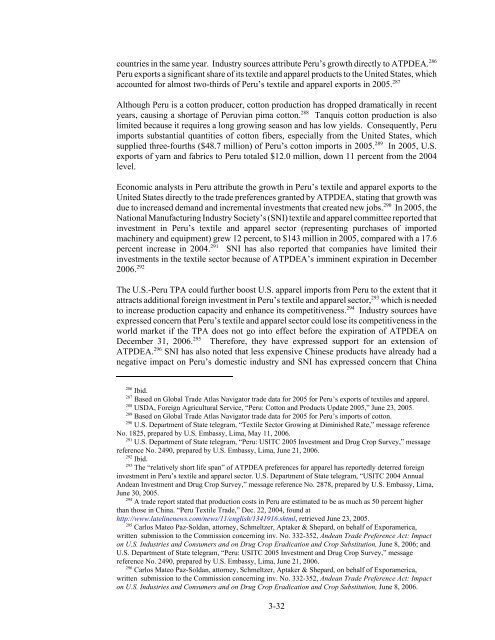The Impact of the Andean Trade Preference Act Twelfth ... - USITC
The Impact of the Andean Trade Preference Act Twelfth ... - USITC
The Impact of the Andean Trade Preference Act Twelfth ... - USITC
- No tags were found...
Create successful ePaper yourself
Turn your PDF publications into a flip-book with our unique Google optimized e-Paper software.
countries in <strong>the</strong> same year. Industry sources attribute Peru’s growth directly to ATPDEA. 286Peru exports a significant share <strong>of</strong> its textile and apparel products to <strong>the</strong> United States, whichaccounted for almost two-thirds <strong>of</strong> Peru’s textile and apparel exports in 2005. 287Although Peru is a cotton producer, cotton production has dropped dramatically in recentyears, causing a shortage <strong>of</strong> Peruvian pima cotton. 288 Tanquis cotton production is alsolimited because it requires a long growing season and has low yields. Consequently, Peruimports substantial quantities <strong>of</strong> cotton fibers, especially from <strong>the</strong> United States, whichsupplied three-fourths ($48.7 million) <strong>of</strong> Peru’s cotton imports in 2005. 289 In 2005, U.S.exports <strong>of</strong> yarn and fabrics to Peru totaled $12.0 million, down 11 percent from <strong>the</strong> 2004level.Economic analysts in Peru attribute <strong>the</strong> growth in Peru’s textile and apparel exports to <strong>the</strong>United States directly to <strong>the</strong> trade preferences granted by ATPDEA, stating that growth wasdue to increased demand and incremental investments that created new jobs. 290 In 2005, <strong>the</strong>National Manufacturing Industry Society’s (SNI) textile and apparel committee reported thatinvestment in Peru’s textile and apparel sector (representing purchases <strong>of</strong> importedmachinery and equipment) grew 12 percent, to $143 million in 2005, compared with a 17.6percent increase in 2004. 291 SNI has also reported that companies have limited <strong>the</strong>irinvestments in <strong>the</strong> textile sector because <strong>of</strong> ATPDEA’s imminent expiration in December2006. 292<strong>The</strong> U.S.-Peru TPA could fur<strong>the</strong>r boost U.S. apparel imports from Peru to <strong>the</strong> extent that itattracts additional foreign investment in Peru’s textile and apparel sector, 293 which is neededto increase production capacity and enhance its competitiveness. 294 Industry sources haveexpressed concern that Peru’s textile and apparel sector could lose its competitiveness in <strong>the</strong>world market if <strong>the</strong> TPA does not go into effect before <strong>the</strong> expiration <strong>of</strong> ATPDEA onDecember 31, 2006. 295 <strong>The</strong>refore, <strong>the</strong>y have expressed support for an extension <strong>of</strong>ATPDEA. 296 SNI has also noted that less expensive Chinese products have already had anegative impact on Peru’s domestic industry and SNI has expressed concern that China286 Ibid.287Based on Global <strong>Trade</strong> Atlas Navigator trade data for 2005 for Peru’s exports <strong>of</strong> textiles and apparel.288 USDA, Foreign Agricultural Service, “Peru: Cotton and Products Update 2005,” June 23, 2005.289 Based on Global <strong>Trade</strong> Atlas Navigator trade data for 2005 for Peru’s imports <strong>of</strong> cotton.290 U.S. Department <strong>of</strong> State telegram, “Textile Sector Growing at Diminished Rate,” message referenceNo. 1825, prepared by U.S. Embassy, Lima, May 11, 2006.291U.S. Department <strong>of</strong> State telegram, “Peru: <strong>USITC</strong> 2005 Investment and Drug Crop Survey,” messagereference No. 2490, prepared by U.S. Embassy, Lima, June 21, 2006.292 Ibid.293 <strong>The</strong> “relatively short life span” <strong>of</strong> ATPDEA preferences for apparel has reportedly deterred foreigninvestment in Peru’s textile and apparel sector. U.S. Department <strong>of</strong> State telegram, “<strong>USITC</strong> 2004 Annual<strong>Andean</strong> Investment and Drug Crop Survey,” message reference No. 2878, prepared by U.S. Embassy, Lima,June 30, 2005.294A trade report stated that production costs in Peru are estimated to be as much as 50 percent higherthan those in China. “Peru Textile <strong>Trade</strong>,” Dec. 22, 2004, found athttp://www.latelinenews.com/news/11/english/1341916.shtml, retrieved June 23, 2005.295 Carlos Mateo Paz-Soldan, attorney, Schmeltzer, Aptaker & Shepard, on behalf <strong>of</strong> Exporamerica,written submission to <strong>the</strong> Commission concerning inv. No. 332-352, <strong>Andean</strong> <strong>Trade</strong> <strong>Preference</strong> <strong>Act</strong>: <strong>Impact</strong>on U.S. Industries and Consumers and on Drug Crop Eradication and Crop Substitution, June 8, 2006; andU.S. Department <strong>of</strong> State telegram, “Peru: <strong>USITC</strong> 2005 Investment and Drug Crop Survey,” messagereference No. 2490, prepared by U.S. Embassy, Lima, June 21, 2006.296Carlos Mateo Paz-Soldan, attorney, Schmeltzer, Aptaker & Shepard, on behalf <strong>of</strong> Exporamerica,written submission to <strong>the</strong> Commission concerning inv. No. 332-352, <strong>Andean</strong> <strong>Trade</strong> <strong>Preference</strong> <strong>Act</strong>: <strong>Impact</strong>on U.S. Industries and Consumers and on Drug Crop Eradication and Crop Substitution, June 8, 2006.3-32
















